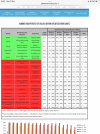HalfpipMarathon
Well-Known Member
- Relationship to Diabetes
- Type 2
Can I ask if anyone takes any notice of the number after the decimal point in BG readings ie 7.9 or 10.2? Especially the latter as 10 is the top end range for Dexcom and Libre.
I ask because if you get a reading of 10.2 rather than 10 does that mean you are not in range?
I'm not too worried just curious.
I ask because if you get a reading of 10.2 rather than 10 does that mean you are not in range?
I'm not too worried just curious.



